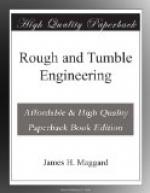By using steam expansively, we mean the cutting off of the steam from the cylinder, when the piston has traveled a certain part of its stroke. The earlier in the stroke this is accomplished the more benefit you get of the expansive force of the steam.
The reverse on traction engines is usually arranged to cut off at I/4, I/2 or 3/4. To illustrate what is meant by “cutting off” at I/4, I/2 or 3/4, we will suppose the engine has a I2 inch stroke. The piston begins its stroke at the end of cylinder, and is driven by live steam through an open port, 3 inches or one quarter of the stroke, when the port is closed by the valve shutting the steam from the cylinder, and the piston is driven the remaining 9 inches of its stroke by the expansive force of the steam. By cutting off at I/2 we mean that the piston is driven half its stroke or 6 inches by live steam, and by the expansion of the steam the remaining 6 inches; by 3/4 we mean that live steam is used 9 inches before cutting off, and expansively the remaining 3 inches of stroke.
Here is something for you to remember: “The earlier in the stroke you cut off the greater the economy, but less the power; the later you cut off the less the economy and greater the power.”
Suppose we go into this a little farther. If you are carrying I00 pounds pressure and cut off at I/4, you can readily see the economy of fuel and water, for the steam is only allowed to enter the cylinder during I/4 of its stroke; but by reason of this, you only get an average pressure on the piston head of 59 pounds throughout the stroke. But if this is sufficient to do the work, why not take advantage of it and thereby save your fuel and water? Now, with the same pressure as before, and cutting off at I/2, you have an average pressure on piston head of 84 pounds, a loss of 50 per cent in economy and a gain of 42 per cent in power. Cutting of at 3/4 gives you an average pressure of 96 pounds throughout the stroke. A loss on cutting off at I/4 of 75 per cent in economy, and a gain of nearly 63 per cent in power. This shows that the most available point at which to work steam expansively is at I/4, as the percentage of increase of power does not equal the percentage of loss in economy. The nearer you bring the reverse lever to center of quadrant, the earlier will the valve cut the steam and the less will be the average pressure, while the farther away from the center the later in the stroke will the valve cut the steam, and the greater the average pressure, and, consequently, the greater the power. We have seen engineers drop the reverse back in the last notch in order to make a hard pull, and were unable to tell why they did so.




